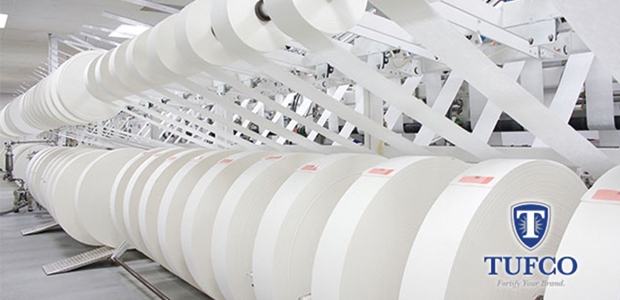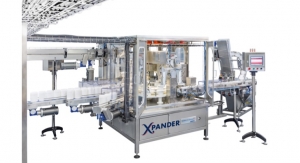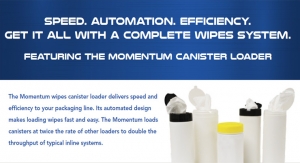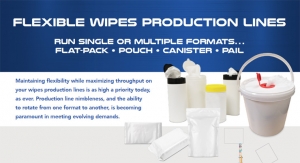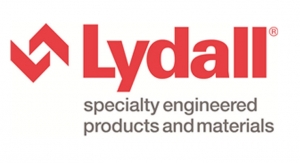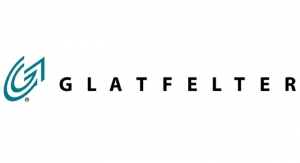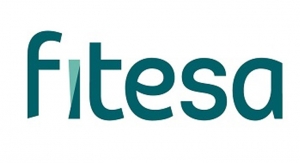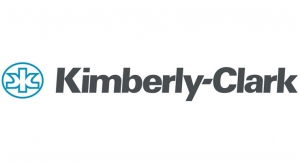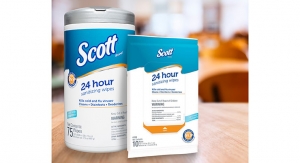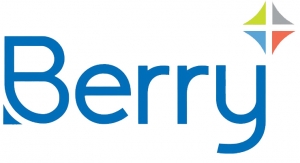Karen McIntyre, Senior Editor03.26.14
The ability to add color or printing capabilities to the wipes substrate is expanding the role wipes are playing across a number of markets. While initial printing efforts have allowed wipes makers to offer brand identification or otherwise differentiate the look of their products, more recent generations of printed wipes are actually offering multifunctionality to the final product.
Initial printing efforts tended to communicate a brand or a need—a company need or an indicator of point of use. For instance in food service red is used in the front and blue in the back. But wipes makers have been teaming up with ink suppliers to provide disappearing inks, or inks able to offer some sort of detection, adding functionality to the product while changing its look.
“Technology has come a long way in terms of what can be printed on wipes,” explains Chris Plotz, product development manager, ITW Professional Brands. “There is more sophisticated printing components that are allowing us to do the kind of printing we have seen on paper for a long time.”
Behind the new technology are advances not only in substrate technology but also with the inks and pigments being used. “The basics are still the same but some of the components have changed,” says Plotz.
A few years ago, ITW Professional was a finalist for the World of Wipes Innovation Award for a product that was able to detect explosives. The wiper would change color when a surface containing TNT or another explosive material was wiped. Plotz says that similar products that offer a multifunctional benefit are in his company’s product pipeline.
“I honestly believe that printing technology is going to change the way that people use wipes,” he says. “It is a big deal. It has the potential to change very, very significantly large segments of the wipes business.”
According to industry observers advancements in printing on wipes can be credited to printing technology, whether it’s flexo, gravure or screen. Last month, Tufco Technologies announced it now offers full-color flexographic printing capabilities on spunbond, super-lightweight nonwoven material. These porous, low basis-weight substrates are common in the personal care and baby care markets. Tufco offers these products in widths of up to 61¾ inches and on material as light as 10 gsm.
Mark Painley, business director of consumer products for Precision Fabrics Group, reports that his company makes spunlaced towels that use printing capabilities to let the user know when they need to be thrown out. “We can adjust the ink loading on the logo or stripe to disappear after 1, 5, 10 or 20 residential wash cycles,” he says.
The type of printing—flexo, gravure, screen—is dependent on the type of nonwoven being printed on. The lighter the basis weight or the more apertured the pattern, the fewer fibers that are available to hold the ink and the print pattern will be intermittent, according to Painley. “If you are simply printing a stripe on one end, that may not matter but if you are trying to print a company logo, it may be too broken up to read,” he says. “The smoother the surface, like a spunlace, the easier to print and if the blend contains a high pulp or rayon content, there will be good absorbency of the ink and better print definition. You will never achieve the definition with wipe material that you could with a wet laid or paper, regardless of the type of printing process you choose.”
Jeff Slosman, president of National Wiper Alliance, says he has had the capabilities to print on nonwovens for a while but only recently has seen a lot more interest in the technology. “It’s all about branding and uniqueness because at the end of the day, we all sell commodities but when you add your name to it, it adds something.”
Currently, National Wiper has three folding lines with dedicated printing ability as well as a new printing line that gives the company the flexibility to integrate it with any folding lines, giving the company unlimited capabilities.
“The flexible print can be moved to any of our lines depending on the size of the converting lines,” says Slosman. “The key to success is being flexible to our customers’ needs.”
At its new building, Nonwovens of America, has a 112-inch converting line as well as capabilities to add more functionality to the wiper. “We have three-dimensional printing, puff printing and multidimensional printing capabilities,” Slosman says. “It’s all about working with the ink supplier. He can put all kinds of things in the wipes such as cleaners, testers for quads and ink that will disappear over time. It’s getting where it’s not just about branding.”
While branding will certainly not lessen in importance, it will take a backseat to these other offerings as they become more cost effective and widespread in the wipes market.
“Brand impressions are a big deal but if you can offer a brand impression and also communicate a certain operation than it becomes even more powerful,” Plotz says. “The product needs to be communicating that the wipe is doing what it is intending. It’s getting the thing clean and detecting the job. If you look at the patents and watch how technology has changed in the marketplace, you will see that printing will become more important in nonwovens substrates.”
Initial printing efforts tended to communicate a brand or a need—a company need or an indicator of point of use. For instance in food service red is used in the front and blue in the back. But wipes makers have been teaming up with ink suppliers to provide disappearing inks, or inks able to offer some sort of detection, adding functionality to the product while changing its look.
“Technology has come a long way in terms of what can be printed on wipes,” explains Chris Plotz, product development manager, ITW Professional Brands. “There is more sophisticated printing components that are allowing us to do the kind of printing we have seen on paper for a long time.”
Behind the new technology are advances not only in substrate technology but also with the inks and pigments being used. “The basics are still the same but some of the components have changed,” says Plotz.
A few years ago, ITW Professional was a finalist for the World of Wipes Innovation Award for a product that was able to detect explosives. The wiper would change color when a surface containing TNT or another explosive material was wiped. Plotz says that similar products that offer a multifunctional benefit are in his company’s product pipeline.
“I honestly believe that printing technology is going to change the way that people use wipes,” he says. “It is a big deal. It has the potential to change very, very significantly large segments of the wipes business.”
According to industry observers advancements in printing on wipes can be credited to printing technology, whether it’s flexo, gravure or screen. Last month, Tufco Technologies announced it now offers full-color flexographic printing capabilities on spunbond, super-lightweight nonwoven material. These porous, low basis-weight substrates are common in the personal care and baby care markets. Tufco offers these products in widths of up to 61¾ inches and on material as light as 10 gsm.
Mark Painley, business director of consumer products for Precision Fabrics Group, reports that his company makes spunlaced towels that use printing capabilities to let the user know when they need to be thrown out. “We can adjust the ink loading on the logo or stripe to disappear after 1, 5, 10 or 20 residential wash cycles,” he says.
The type of printing—flexo, gravure, screen—is dependent on the type of nonwoven being printed on. The lighter the basis weight or the more apertured the pattern, the fewer fibers that are available to hold the ink and the print pattern will be intermittent, according to Painley. “If you are simply printing a stripe on one end, that may not matter but if you are trying to print a company logo, it may be too broken up to read,” he says. “The smoother the surface, like a spunlace, the easier to print and if the blend contains a high pulp or rayon content, there will be good absorbency of the ink and better print definition. You will never achieve the definition with wipe material that you could with a wet laid or paper, regardless of the type of printing process you choose.”
Jeff Slosman, president of National Wiper Alliance, says he has had the capabilities to print on nonwovens for a while but only recently has seen a lot more interest in the technology. “It’s all about branding and uniqueness because at the end of the day, we all sell commodities but when you add your name to it, it adds something.”
Currently, National Wiper has three folding lines with dedicated printing ability as well as a new printing line that gives the company the flexibility to integrate it with any folding lines, giving the company unlimited capabilities.
“The flexible print can be moved to any of our lines depending on the size of the converting lines,” says Slosman. “The key to success is being flexible to our customers’ needs.”
At its new building, Nonwovens of America, has a 112-inch converting line as well as capabilities to add more functionality to the wiper. “We have three-dimensional printing, puff printing and multidimensional printing capabilities,” Slosman says. “It’s all about working with the ink supplier. He can put all kinds of things in the wipes such as cleaners, testers for quads and ink that will disappear over time. It’s getting where it’s not just about branding.”
While branding will certainly not lessen in importance, it will take a backseat to these other offerings as they become more cost effective and widespread in the wipes market.
“Brand impressions are a big deal but if you can offer a brand impression and also communicate a certain operation than it becomes even more powerful,” Plotz says. “The product needs to be communicating that the wipe is doing what it is intending. It’s getting the thing clean and detecting the job. If you look at the patents and watch how technology has changed in the marketplace, you will see that printing will become more important in nonwovens substrates.”

